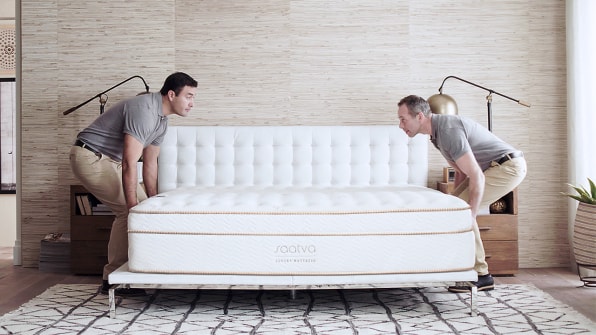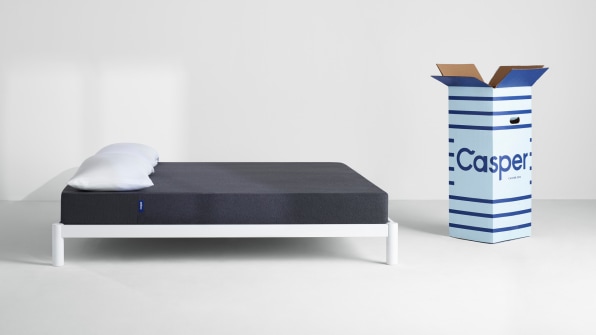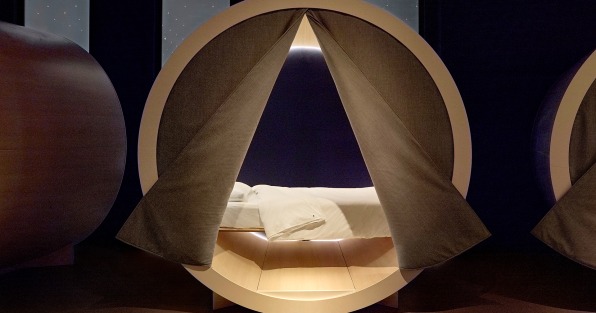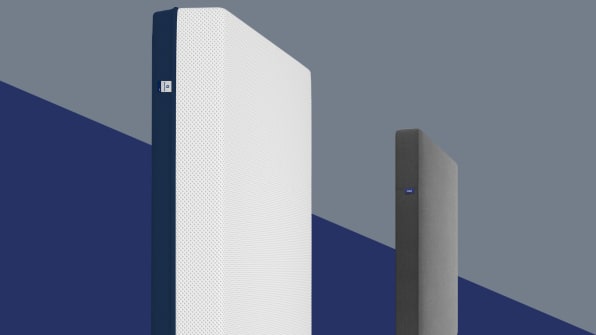There’s a $29 billion battle being waged on the internet to become America’s mattress of choice. You’re probably already aware of this, if you’ve ever even casually looked at a mattress online, only to find yourself drowning in banner ads featuring attractive people taking naps on impossibly cozy-looking beds.
Among the startups hawking their wares, there’s Purple, whose mattresses are designed to relieve pressure in your back; Eight, which will track your sleep cycles using monitors; and Tuft & Needle, whose mattresses start at the rock bottom price of $350. Adding to the noise, established retailers are moonlighting with their own online mattress brands: Last year Serta Simmons launched Tomorrow Sleep, Mattress Firm launched Tulo, and Walmart launched Allswell. And that’s just the tip of the iceberg: The last time I counted, there were 178 different online mattress brands, with new ones popping up every day.
The endgame is clear: Each of these brands wants to convince you to drop hundreds, if not thousands, of dollars on their mattresses without so much as touching it first to see how springy it is. But in the midst of this heated warfare, brands are opting for very different strategies to come out on top.
On one side are the oldest players on the market–Saatva and Amerisleep–which pioneered selling mattresses online back in 2010, when most people would have laughed at the idea of buying such an enormous, bulky item on the internet. The founders bootstrapped these companies, pouring profits back into the business, and growing slowly. But after eight years, both brands have large customer bases. Saatva generated $207 million in revenue last year and has a five-year plan to make between $800 million and $1 billion in revenue. Meanwhile Amerisleep is now expanding into the Australian and Korean markets, and is growing an international network of stores.
Casper, on the other hand, is aiming to scale fast. It launched in 2014, four years after Saatva and Amerisleep, but thanks to a mother lode of $239.5 million in VC funding, it now has the largest market share among the online mattress brands. (For comparison, Casper surpassed $200 million in revenue after two years; Saatva took eight years to reach the same milestone.) To reach a wider market, Casper has gone beyond the online, direct-to-consumer model, by selling products at Target, Nordstrom, and Amazon as well as a network of brick-and-mortar stores, of which it hopes to have 200 in the next two years.
Related: Casper’s next frontier: Your entire bedroom
Casper’s VC-fueled growth has opened up both opportunities and risks. The question is, which approach is more likely to succeed in the long run? When is rapid growth necessary to survival, and when does it become unsustainable?

Slow and steady: Amerisleep and Saatva
Until recently, there was only one way to buy a mattress. You had to schlep to a showroom where–under the harsh glare of yellow overhead lights–you would awkwardly lie on beds while strangers and sales associates stared on. “We saw a huge opportunity in a broken industry,” says Amerisleep co-founder and CEO Firas Kittaneh. “People hated going to the mattress store and the logistics of trying to get that mattress into your home was a nightmare.”
Back in 2010, Kittaneh took his savings and poured it into an online startup, Amerisleep, based in Phoenix, Arizona. He found an American manufacturer who could produce eco-friendly mattresses in five levels of firmness, to cater to different preferences. He also worked to find a way to compress the mattress into a box so that it could be delivered by mail, much like you would receive a book from Amazon. Amerisleep is an entirely vertically integrated company: It controls everything from the design to the final delivery.
“Consumers were poorly educated about mattresses,” Kittaneh says. “They went into stores and could not tell whether they were getting value for their money because sales associates were trying to get a commission from the sale. On our site, we wanted our customers to know where our product was made, how it was made, and what was inside it.”
And price was on their side too. Thanks to Amerisleep’s direct-to-consumer model, they were able to sell the mattresses at a starting price of under $800, which was at least 50% cheaper than what retailers were charging for a product of similar quality. And soon customers started pouring in. By year three, Amerisleep’s website was getting 122,000 page views a month and converted 2.85% of visitors into buyers. (In other words, roughly 3,500 mattresses were purchased a month.)
While Kittaneh was building Amerisleep in Arizona, Rudzin was trying out his own experiment in New York. He joined forces with millennial entrepreneur, Ricky Joshi, and with $350,000 of their own money, they bootstrapped Saatva. Rudzin wanted to disrupt the higher end of the market, where the savings to the consumer would be more dramatic. While brands like Tempur-Pedic and Stearns & Foster were selling foam mattresses for between $2,000 and $8,000, Saatva’s mattresses–sold under the Saatva, Loom & Leaf, and Zenhaven brands–ranged from $1,100 and $1,900.

Since consumers couldn’t test a Saatva mattress, Rudzin thought it was important to provide them with the most convenient shopping experience possible. Rudzin contracted with a network of delivery companies so that customers would be able to schedule white glove delivery for free. The mattress would be unpacked in the room of their choice and all packaging would be removed. If the buyer decided the Saatva mattress wasn’t for them, they could get a full refund and a team would come to pick it up. “It’s just not possible to compress really high-quality mattresses,” Rudzin says. “But also, how is it a convenient experience if you have to carry a big box into your house then unpack it?”
By now, Amerisleep and Saatva are established players in the mattress market, but it took a while to get here. Both brands invested in social media and search engine advertising, as well as commissions to mattress bloggers who used affiliate links in their reviews, but all of this was fairly inexpensive early on when there were few players on the market. “I think I’m fairly risk-averse,” Rudzin tells me. “That’s just how I am built. I’d rather go slower and have more equity than gamble with someone else’s money.”
Over time, their approach has led to significant growth. Saatva now has 190 employees. It produces mattresses at a network of 19 factories and partners with 155 delivery firms to get them into customers’ homes. After eight years in business, Saatva just took its first ever investment of an undisclosed amount from private equity firm, TZP Group, and launched a national advertising campaign. It has announced a five-year plan to reach between $800 million and $1 billion in revenue and is also working towards an IPO within three years.
Amerisleep does not share revenue figures, but a spokesperson for the company says it has sold hundreds of thousands of mattresses, has consistent triple-digit growth year-over-year, and has a staff of 50. It now delivers to Australia, opened its first five stores in the U.S. and its first three stores in South Korea over the last year, and is on track to open its first major international flagship in Seoul.
“We still haven’t taken any investment,” Kittaneh tells me. “We wanted to grow the brand at a reasonable pace, investing our profits back into the business to fund our own growth. We may have grown slower that some of our competitors, but we think this is more sustainable.”
Here, Kittaneh is speaking about one competitor in particular: Casper.

Fast and furious: Casper
In many ways, Casper appears to be winning the war for the American mattress. In four short years, it is now the top online mattress brand by market share, followed by Tuft & Needle.
But achieving this level of brand awareness in such a short time comes at a cost. Casper spends an estimated $80 million a year on marketing. It blankets billboards, taxis, and subways in major cities with ads, and has also invested in national TV, radio, and podcast ads. It has also spent money making sure that it has favorable reviews on mattress blogs, which are an important driver of traffic to online mattress websites. Last year, Fast Company reported about how Casper sued three mattress bloggers, who had posted negative reviews, for false advertising.
Saatva, on the other hand, has been far more judicious about its marketing. After seven years in business, it has just launched its first TV commercials. “We have always been very ROI-focused when it came to marketing,” Rudzin says. “I never threw money to the wind. This year, thanks to our manufacturing and delivery network, we are now in a position to go out and build our brand, and put big money behind it.”
Amerisleep, for its part, hasn’t invested much in branding at all. “We’ve been a little bit sleepy when it comes to media and flashy marketing,” Kittaneh says. “We’ve been so focused on the engineering of the product and thinking about what makes people sleep better. But the fact that Casper has pumped so much money into branding has actually helped grow awareness of the online mattress category as a whole, so we see it as a good thing.”
Another way that Casper has been growing is by expanding its product range. It’s a smart move because people buy mattresses infrequently; if you can convince a customer to return to purchase more sleep-related products, you’re able to extract more lifetime revenue from them. While Saatva and Amerisleep have created their own pillows and bedsheets to go along with their mattresses, Casper, in typical fashion, has been far more aggressive about developing and releasing new products. Besides bedsheets and pillows, Casper sells dog bed, a nap pillow, a humidity-fighting duvet, and even furniture, like nightstands and bed frames. Many of these products come out Casper Labs, a state-of-the-art sleep research facility that Casper launched in early 2017.
And perhaps most surprising of all is that Casper is now focused on opening 200 brick and mortar stores, possibly its most expensive endeavor yet. The move makes some sense. For all the talk of online mattress brands disrupting the industry, some retail analysts believe that 95% of consumers still prefer to buy beds in stores. And even though Casper is among the mightiest of the digital brands, it still only controls 0.7% of the market. “Consumer demand to touch and feel our products in-person has been extremely high since day one,” Philip Krim, Casper’s CEO, writes in an email. “A big learning we had when opening our first retail locations was that a large percentage of people want to take their mattress home with them from the shop. As such we’ve adjusted our in-store inventory accordingly.”

But physical stores carry some risk. Just ask Mattress Firm, the retailer that has the largest market share of 11%. Mattress Firm achieved this dominance, in part, thanks to its massive network of more than 3,000 stores around the country. But these stores have also been a liability. Mattress Firm is reportedly considering filing for bankruptcy and has been shuttering hundreds of stores in the interim. While online mattress brands can be nimble with their website strategy, changing the online user experience at the drop of a hat, renting retail space often requires long, inflexible leases. And as the so-called retail apocalypse taught us, consumer shopping behavior can change rapidly, rendering entire malls vacant.
It’s true that Mattress Firm, much like other large mattress retailers, hasn’t done much to innovate on the customer experience in stores. Casper, on the other hand, has worked hard to create interesting and entertaining experiences in its existing in-person pop-ups. In 2016, it launched a 15-city Mobile Nap Tour that gave people a chance to test out a mattress on a bus equipped with nap pods. This year, it launched another concept called The Dreamery, where people could pay $25 to take a 45-minute nap, complete with designer pajamas and a sleep mask. “We are reimagining how people shop for sleep by listening to customers and creating an atmosphere they actually want to visit,” Krim says. “We believe that brick-and-mortar retail is here to stay–but retail poorly done is on its way out.”
Casper seems to be counting on stores as in its bid to dominate the mattress industry–but rolling out 200 in two years is an awfully rapid expansion.
Amerisleep has also seen the benefit of brick-and-mortar retail, but it has been opening stores at a much slower pace.Last year, the company opened its first location and it has slowly rolled out a total of eight stores, most of them in Arizona and Colorado, where the founders can keep a close eye on them. The company is also hoping to launch a flagship in Seoul, Korea, shortly. The heart of the Amerisleep store is the “Dream Suite” where customers can test out mattresses in a relaxing, private area. “We wanted to roll the stores out slowly,” Kittaneh says. “So we could make adjustments along the way, based on customer feedback.”

Going to the mattresses
Over the last few years, we’ve seen several VC-fueled startups crash and burn. I’ve documented some of these issues in another story, about brands like Nasty Gal, Bonobos, Gilte Groupe, and Fab, which all took large amounts of funding but were eventually sold off for a fraction of what investors had poured into them. In most cases, the VC money came with unreasonable growth expectations, and the companies made compromises that eventually undid the brand. Often, office culture also took a hit, because the companies were hiring too quickly.
Casper is a unique company in a very different industry, so these comparisons are inherently limited. Its founders may very well learn from the cautionary tales of other startups and avoid these pitfalls. “We’re in a marathon sprint,” Chapin says. “We’re trying to build a substantial, long-lasting company and trying to do it fast. I think our employees are a little tired but also very excited–it’s fulfilling when you see the product in store and online, then get incredible feedback about them.”
And perhaps Casper’s aggressive strategy is warranted, given the hundreds of virtually identical bed-in-a-box brands flooding the market right now. Throwing money into branding and customer acquisition may be the only way for a brand to stand out. “I don’t think I could launch Saatva with only $350,000 of my own money today,” says Rudzin. “We didn’t have to fight so hard to be heard and we didn’t have to pour so much money into acquiring each customer online.”
In an interesting coincidence, Casper and Saatva may go public at around the same time. Last summer, when Casper got its latest $170 million infusion of capital led by Target, CEO Philip Krim said that the company was considering an IPO. This month, Rudzin said that the company may consider a public offering when it reaches $300 million to $400 million in revenue, which could happen in as quickly as two years. Going public would suddenly create oodles of new money that could allow that company to substantially increase its market share–though it would come with strings attached, in the form of shareholder pressure to remain profitable. But one thing is clear: Should Casper or Saatva IPO, it would be considered an enormous success–perhaps even a sign that a victor had been crowned in the online mattress wars.
But until then, the battle wages on. And like it or not, everywhere you turn on the internet, you’ll find yourself pelted with images of comfy beds, fluffy duvets, and plump pillows.
https://www.fastcompany.com/90216464/the-29-billion-battle-to-own-how-america-sleeps?partner=rss&utm_campaign=rss+fastcompany&utm_content=rss&utm_medium=feed&utm_source=rss






